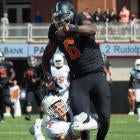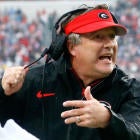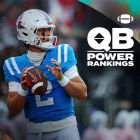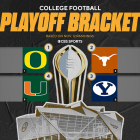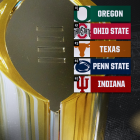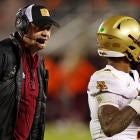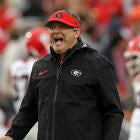Watching a bank of televisions last Saturday at the CBS Broadcast Center in New York, one college football production assistant barked out, "This game is sailing along."
He was right. Army and Air Force were on their way to playing a nationally televised game in a brisk 3 hours, 8 minutes. It was a definite rarity. Watching college football has never required such a time commitment.
Week 11 debuts with the average game being played in a record length of 3 hours, 24 minutes. Four-hour games have become the norm. Texas A&M beat Tennessee 45-38 in a double-overtime game that lasted 4 hours, 43 minutes. The highest-scoring game of the season between Oklahoma and Texas Tech (66-59) went 4:10.
Last month, Cal and Oregon ran a combined 203 plays in a double-overtime game. The Bears snapped it an FBS record 118 times.
An average Oklahoma State game lasts three minutes short of that four-hour mark. The Wall Street Journal in September reported it was possible to fly from Los Angeles to Washington, D.C. in less time than it took to play a college football game.
Yes, that 3:24 average would be a record. It would also be a bit misleading.
We can talk about endless commercial breaks, but with TV being TV, that's old news. The number of commercials basically remains static (see below). Reality TV has proven to be some of the highest-rated television. Whether its "Big Brother" or Alabama-Tennessee, those programs are -- in some ways -- always profitable platforms for commerce.
You want a reason? Turns out the so-called "fastest" offenses also play the slowest. Four teams in the top 10 in average plays per game are also among the top 10 in slowest games (Texas Tech, Cal, Baylor and Texas).
Let's take Baylor, which is fourth nationally averaging 85.4 points per game. It plays the second-longest games, averaging an interminable 3 hours, 50 minutes.
Tempo teams run more plays. More plays mean more first downs. More first downs mean more stoppages of the clock. College football is unique in that it stops the clock to spot the ball after each first down.
Record scoring (30.3 points per team) means more frequent stoppages. That means the average game is halted 10 times for traditional scores (touchdown or field goal). In the nation's highest-scoring league (Big 12), that number is 11.5 stoppages per game.
"The games are taking a long, long time," said Baylor coach Jim Grobe. "The way we throw the football around, playing a team that is talented offensively that can make for a long game."
Not surprisingly, five of top nine teams in average game length play in the Big 12. Oklahoma State leads the country at 3:57. To be fair, on consecutive Saturdays the Cowboys had games delayed by weather by a combined 3 hours, 13 minutes. Even subtracting those delays, the Cowboys are near the top at 3:35.
"I think it's fair to start talking about the length of games," Oklahoma State coach Mike Gundy said. "The pace of offenses, increased plays, number of attempted passes and maybe -- more so in our league -- is affecting the games.
"I'm a little surprised we haven't heard much from the networks on this. There's probably a fairness to talking about games being 12-minute quarters instead of 15 based on the amount of time the clock is stopped based on forward passes that are incomplete."
| Team | 2016 Game length |
| 1. Oklahoma State | 3:57 |
| 2. Baylor | 3:50 |
| 3. Texas Tech | 3:49 |
| 4. Cal | 3:46 |
| 5. Texas | 3:45 |
| T6 Texas A&M | 3:42 |
| T6 South Alabama | 3:42 |
| 8. Tennessee | 3:40 |
| 9. TCU | 3:38 |
| 10. Oregon | 3:37 |
It's unlikely networks are going to cut down actual playing time. The average game includes 68 30-second commercials. That's 34 minutes of ads built into your eyeballs from the moment the cameras come on.
And it doesn't seem to matter. While NFL ratings are tanking, college football TV ratings are even or perhaps a bit up. While the NFL deftly shoehorns its games into three-hour TV-friendly slots, college games are more Woodstock than TV window.
"Our tailgaters, for a 3:30 kick, are here at 5 a.m. -- and they don't leave early," Ohio State athletic director Gene Smith told me last year. "We could actually have a blowout and they're still here."
And no, the SEC doesn't play the longest games at an average of 3 hours, 26 minutes. It is only third behind the Big 12 (3:32) and the Pac-12 (3:27).
The longer-game phenomenon is basically only a decade old. The game reacted after the disastrous rules changes in 2006 when the clock was allowed to run on kickoffs (when toe met ball) and during changes in possession.
The moves were meant to shorten game times, but they eventually cut into the quality of the game. Games lasted only 3:07 on average in 2006. That's 17 minutes shorter that today. In 2006, teams ran an average of only 64 plays per game. That's eight less than the current average (72, another record).
What's changed? The 40-second play clock was introduced in 2008, but it ultimately had the opposite of the intended effect. Up tempo offenses used it to measure how quickly they could snap the ball.
The replay review process began in 2005. The average number of stoppages has risen steadily to a record 2.17 per game this season. The ACC leads the way with 2.58 per game. (Latest NCAA numbers are through games of Oct. 29.)
A record 727 games last season included at least one review stoppage. Through nine weeks, that record was on pace to be shattered -- 765 games before the bowls even kick off.
On those stoppages, Western Michigan's P.J. Fleck said, "You ask an official, 'Hey, it's 11:30 p.m. When you're down by 30, or up by 30 who's actually watching?'"
Enough folks, it turns out.
Bob Bowlsby said game length has gotten the attention of the NCAA Football Oversight Committee that he chairs.
"If we decided we weren't going to kick off anymore or only kickoff in certain situations, you save a fair amount of time then," said Bowlsby, also the Big 12 commissioner. "That's exactly why we put the oversight committee together -- to take a holistic look at it. It's going to continue to be on our agenda."
Discussion of this subject wouldn't be complete without comment from Mike Leach. The Washington State coach is one of the inventors of the spread offense so responsible for all those passes, all those incompletions, all those plays, and thus, all those stoppages.
In fact, his quarterback Luke Falk has thrown more passes (1,073) and more incompletions (308) than anyone the last two seasons. Still, the Cougars are playing games in a relatively crisp 3:28.
"I'll certainly continue to do my part seeing they get the longest show we possibly can," Leach said, tongue firmly planted in cheek.
Nick Saban's genius: Coaches are grumbling that Alabama is able to use former players Blake Sims (prior to Texas A&M) and Trent Richardson (before LSU) to help tune up Saban's team in practice before big games. It's not only legal but another example of Saban mining the NCAA Manual for advantages.
Bylaw 14.2.1.6 states: A former student at the certifying institution (e.g., former student-athlete) may participate in an organized practice session on an occasional basis, provided the institution does not publicize the participation of the former student at any time before the practice session.
That checks out. We didn't find out about Sims and Richardson until after the fact. The rule Saban took advantage of was adopted in 2011. It doesn't matter if the players are in the NFL or not. Alabama was able to bring back its single-season total offense leader (Sims) and Heisman Trophy finalist (Richardson) just a few short years after their eligibility expired.
The key word in the bylaw is "occasional." That's vague and undefined. What's more (possible) genius: The rule doesn't limit the amount of former players that can be brought in.
With Auburn looming, it might be wise for AJ McCarron, Amari Cooper, Barrett Jones, C.J. Mosley and Mark Ingram to hang by their phones.
Armaggedon: We're deep enough into the season to consider this possible College Football Playoff mind bender: No undefeated Power Five teams, six-one loss teams and three two-loss teams in the playoff mix after the games of Dec. 3.
Here's what's left ...
- West Virginia finishes 11-1 to win the Big 12
- Virginia Tech (projected record 11-2) beats Clemson (12-1) in the ACC title game
- Auburn (11-2) beats Alabama (11-1) and goes on to win the SEC
- Wisconsin (11-2) beats Michigan (12-1) in the Big Ten title game
- Washington State (11-2) beats Washington (11-1) and goes on to win the Pac-12
In that scenario, the Football Four looks like this ...
- Wisconsin (11-2) as Big Ten champion
- Auburn (11-2) as SEC champion
- Michigan (12-1) at large as Big Ten East champion with a split against Wisconsin
- Alabama (11-1) at large as second place in SEC West going 4-1 against teams ranked this season. Only playoff team to play 12 games but No. 1 all season.
That makes two from the SEC, two from the Big Ten --and a pair of two-loss teams. Three Power Five conference champs (ACC, Pac-12, Big 12) are left out. The playoff doesn't include Clemson, champion of the ACC Atlantic, which owns a win over Auburn.
Your thoughts?
The Big Ten is saying it while not saying it: The Friday night gambit beginning in 2017 is a way to get more exposure for the league's bottom feeders. The league has its own network, is No. 2 in revenue but it needs more Northwestern-Maryland games in Friday prime time? Apparently.
The league announced its 2017 Friday schedule this week. The schedule includes eight of the 14 schools but only two you'd consider traditional powers -- Wisconsin and Michigan State. Northwestern appears twice.
The outcry from heartland high school types has justifiably been long and loud. In this particular situation, the Big Ten surrendered some of the moral high ground choosing a few more bucks while forcing fans to choose between Friday Night Lights and Friday Night (Big Ten) Lightweights.







